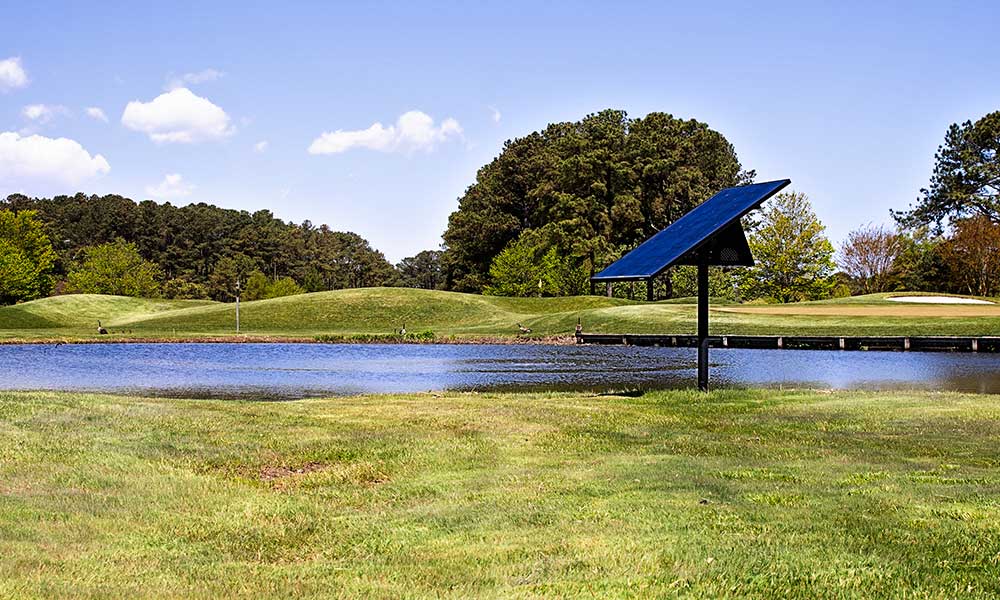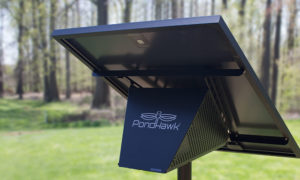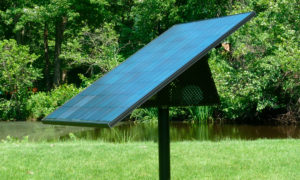LINNE Industries learned a lot about pond health after collecting water quality data from the ponds of a Midwest municipal golf course. The course, a LINNE client, has installed 15 PondHawk systems – five per year since 2018. PondHawk is LINNE’s solar-powered subsurface aeration offering. Now the company is sharing what they learned.
In August 2020, LINNE Industries learned that this client had procured a comprehensive assessment of their golf course ponds in 2018, just a few months before installing their first five PondHawk systems. The objective of their research was to understand the baseline conditions and provide best management solutions for the development of an operations and maintenance plan. The data was collected and analyzed by an environmental engineering firm and included measuring temperature, total phosphorus and nitrogen, dissolved oxygen, ammonia, nitrite, nitrate, pH, turbidity, conductivity, sediment buildup, and observational data.
The Starting Point
The municipality had concerns with aesthetics, water quality, and the functionality of its stormwater ponds. Pond aesthetics were deteriorating due to excessive algae growth and buildup was beginning to impair stormwater management capability.
The golf course ponds are in an EPA-designated impaired watershed that covers an area of approximately 48 square miles (30,720 acres). In the watershed, 78% of the land is developed, 15% is in row crops, 4% is forested, 2% is grass/pasture and 1% is “other.” The golf course maintains 50 acres of fairways, 18 acres of rough, five acres of greens, and six acres of the driving range around 34 acres of water. While designated buffer areas are not mowed, golf carts frequently drive through buffer areas as an alternative path when paved cart paths are intermittently blocked. The golf course employs best management practices in mowing height and frequency, but the observational research found that the residents surrounding the golf course mow grassy buffers to the shoreline, employ haphazard lawn fertilization, and feed the wildlife.
The Environmental Engineers’ Findings
In addition to citing subsurface aeration as a “proven effective solution with long term low cost and high overall ecological impact,” the environmental engineers recommended a range of best management practices including community education on mowing habits and ending wildlife feeding, increasing buffer widths, adding littoral shelves and forebays, chemical and biological treatments, and examining the feasibility of dredging. The engineers noted that the golf course observed a “large aesthetic improvement within one week” of PondHawk installation.
What LINNE Replicated
With the valuable baseline data that was collected before the PondHawk installations, LINNE Industries sought to measure the changes after two years of PondHawk aeration. We deployed an Aqua-Troll 500 multiparameter sonde to collect temperature, pH, conductivity, turbidity, and dissolved oxygen (DO) levels at various locations and compared the parameters with those documented in 2018.
Our comparative assessment focused on the pond that originates at Hole 14 and drains into the pond on Hole 15. These ponds are part of an interconnected series that act as a filter before the water exits the property and drains into a nearby stream. The pond is directly adjacent to areas of recent or active construction and collects run-off from an agricultural field giving it a regular source of nutrients and sediments.
From the boat with the Aqua-Troll 500 multiparameter sonde, LINNE industries collected samples from 151 locations across the pond at 1, 2, 4 and 6’ depths.
LINNE’s Dissolved Oxygen Findings
Low DO levels are unable to support aquatic life and lead to anoxic conditions in the bottom sediment. The anoxic condition allows an internal nutrient-loading process by re-released nutrients that were formerly bound to the sediments. Pond stratification can also lead to low DO when a barrier or thermocline prevents mixing oxygen-rich surface water from circulating with the deeper water that is low in DO. By adding subsurface aeration, the thermocline is disrupted, and oxygen-rich surface water is circulated throughout the water column while reducing temperature stratification that can lead to “turnover” in the water that is harmful to aquatic life.
The Best Management Practices Planning Guide, by the United States Golf Association and the Golf Course Superintendents Association of America, recommends DO levels above 2 mg/L to prevent fish kills. The United States Geological Survey recommends that DO levels be a minimum of 5.0 mg/L.
The 2018 baseline sampling of Pond 15 measured the DO of 0.45 mg/L at 6 feet. The sample at 6 feet in 2020 was up to 6.27 mg/L at the same 6’-deep location, an improvement of 5.82 mg/L at 6 feet.

Additional Water Quality Findings
The temperature samples from 2018 indicated higher water temperatures at 2 feet of depth and lower temperatures at 6 feet of depth. In 2020, the Aqua-Troll monitor readings found reduced temperature stratification with lower surface temperatures and higher bottom temperatures than the baseline values. When subsurface aeration was added to the pond, the colder water at the bottom was mixed with the warmer surface water and circulated the water column, eliminating the thermocline barrier.
Turbidity levels at 2- and 6-foot depths also improved since 2018. Reduction in turbidity is indicative of reduced suspended sediment and/or plant material in the water column. The recommended range is 1 – 50 NTU1. In the baseline study, turbidity measured 11 NTU and 231 NTU at 2 and 6 depths, respectively. The samples taken in 2020 measured turbidity at 1.29 NTU and 5.51 NTU at 2- and 6-feet depths, indicating a reduction in suspended matter in the water column.
While the conductivity of the 2018 water samples were within the goal range (100-800 µS/cm is considered acceptable with readings less than 600 µS/cm considered optimal2), the 2020 samples ticked down slightly, indicating reduced pollution or dissolved material in the water column.
Key Takeaways
- PondHawk delivers notable improvement in DO levels and destratification of temperature throughout the water column.
- Bubblers and diffused aerators are more proficient at adding oxygen to the entire water column than surface aerators.
Using solar aeration allows for PondHawk systems to be installed throughout a golf course without disruption to existing infrastructure.
LINNE Industries recognizes that water sampling is a snapshot in time, and conditions that influence values can fluctuate hourly, daily, and seasonally. Nutrients and sediment from the watershed, detritus from trees, algae blooms, and aquatic plants, rain or lack of rain, wind or lack of wind, can all instantaneously change the water conditions. With these variables in mind, LINNE Industries continues to conduct primary water quality research and develop innovative product improvements that improve water quality in a golf course, stormwater, and community ponds.
1Nephelometric Turbidity Units
2microSiemens per centimeter

























